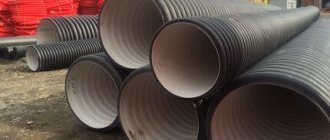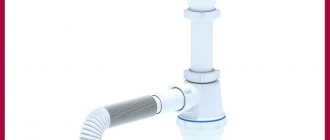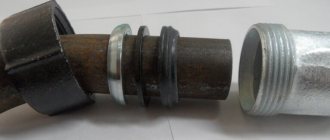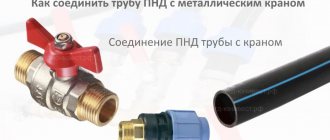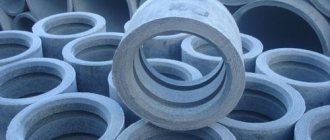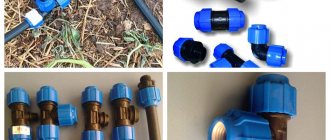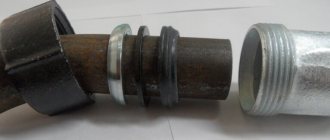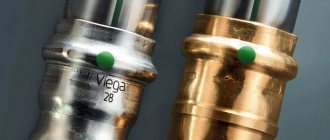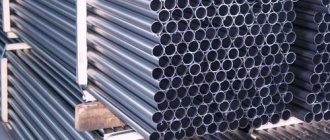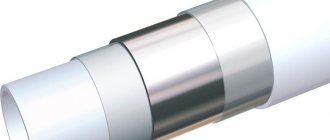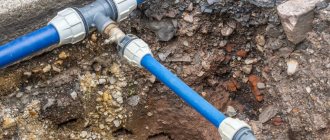Flanges for polyethylene pipes, flanges for HDPE bushings, flanges for collars. We are often sent such requests and we have indeed supplied a lot of such products of various diameters. In this article I want to talk about steel flanges that are used in conjunction with a polyethylene sleeve.
The first thing you need to understand is that the steel flange for HDPE bushings is the same flange according to GOST 12820, which is butt welded to a steel pipe. Why is that. The fact is that when we select a flange, we first of all must understand what equipment we want to connect the pipe to and only then we must take into account what diameter and what type of material the pipe is. Once again, the most important thing is not the pipe, but, say, a valve or flanged valve that we want to “hang” on the pipe.
Selecting a flange for a 160 mm HDPE bushing and a 150 mm valve.
Our task is to install an MZV 30ch39r cast iron valve with a diameter of 150 mm on a 160 mm HDPE pipe. The first thing you need to figure out is which flange the valve itself has. Let's look at the specification:
- n number of bolts - 8 pcs;
- d diameter of holes for bolts - 22 mm;
- D outer diameter of the flange - 280 mm;
- D1 distance/diameter between the center of two holes - 240 mm;
- DN internal diameter of flange and valve 150 mm.
It is intuitively clear that if we need a flange in accordance with GOST 12820, then we need to choose a 150 mm flange. However, here we need to remember that the flange is installed on a HDPE bushing, which means we need to understand the following: can we install a flange, whose internal diameter is approximately 155 mm according to GOST 12820, on a HDPE bushing with an outer diameter of 160 mm. It is already obvious that the outer diameter of the bushing is at least 160 mm, but if we look at the photo and diagram, we will see that the bushing has some thickening and for a 160 mm bushing this thickening leads to the fact that the real diameter is in the place where the flange will “hang” will be equal to 175 mm (look at the diagram H2 = 175 mm).
And the flange has 155 - 160 mm, that is, it will not be possible to hang a standard flange according to GOST 12820 on such a sleeve. Understanding all this, manufacturers in Russia began to grind such flanges to the required internal diameter, and a large number of workshops appeared that specialized in boring flanges. And therefore, the internal diameter of our flange for this unit will be equal to 178 mm. Thus, flanges for HDPE bushings are often called bored.
However, today, most manufacturers in Russia and China have adapted to these needs and produce copies of flanges in accordance with GOST 12820, which are fully consistent with conventional welded flanges, with the exception that the inner diameter of these flanges corresponds to the outer diameter of the bushings.
Flange welding methods
The tightness of the system depends on the correct connection of the pipeline elements. Welding of the disk is carried out using two methods:
- Butt welding involves the formation of a seam along the entire circumference of the rolled product in one place.
- Welding of the mounted disk along two walls: outer and inner.
Working with flanges requires experience; such welding is not trusted to beginners. Any misalignment of the welding surfaces leads to depressurization of the butt joint and increases the risk of a breakthrough in the high-pressure main pipeline.
Flange connections - we assemble the pipeline quickly and efficiently
The flange is made in the form of a threaded part. It is most often used to connect metal and polyethylene water pipes, as well as gas communications without welding. Flanges for assembling household networks from different materials have not only threads on one side, but also a mandatory seal. The latter is located at the second end of the described element. The seal guarantees a tight and truly strong connection, which can always be disassembled if necessary.
Flange connection example
To lay communications you can use:
- metal flanges;
- flanges for special bushings (they are called collars).
Experts advise home craftsmen to connect PE pipes using the second of these methods. In this case, the connection is of the highest quality. Flanges for bushings are made of steel 20. Flanges for polyethylene pipes are designed for operating pressure up to 1.6 MPa. These parts are manufactured with a cross section from 20 to 1200 mm. Therefore, problems with selecting suitable elements for creating detachable connections never arise. There are several subtleties of assembling communications using flanges. We present them below:
- flanges supported by cone-type bushings should be used when working with pipes with a cross-section above 200 mm;
- light pipe products made of PE with a diameter of 150–300 mm, as well as heavy ones with a cross-section of less than 150 mm, are best connected using flanges with a straight shoulder;
- To increase the strength characteristics of connecting pipes made of different materials, you can use straight-shaped bushings with a special conical transition.
When choosing flanges for creating detachable connections, pay special attention to the quality of fasteners. They are not allowed to have burrs or sharp edges. Such defects can cause damage to PE pipes. The flange connection of polyethylene pipes with a cross-section of more than 50 mm is made according to a simple scheme. You need to evenly cut the pipe product in the place where it will dock with another part of the communication. After this, you carefully pull the flange onto the pipe and put a rubber gasket on top.
Such a sealing element can extend beyond the cut by a maximum of 1 cm, no more. You then slide the flange over the gasket and mate it (using bolts) to the mating flange. The bolts must be tightened very carefully. If you apply excessive force during this procedure, the polyethylene pipe may crack.
Types of flanges for polyethylene pipes and features of their application
When laying a pipeline from polyethylene pipes, a flange for PE pipes is used to solve problems related to connecting them with each other or with reinforcing elements. What flange fittings are, as well as the features of installing such a connection, are discussed in this article.
Flange for PE pipes
Product Features
Structurally, the fixing flange for PE pipes is a flat ring, or rather a disk, in which holes are located at the same distance. These holes are used to secure the connection using bolts (studs). Flanges are installed together with a collar or sleeve.
The sleeve for the PE flange directly in front of the flange has a special expansion for reinforcement, due to which the flange does not fit tightly against the flange. To solve this problem, bored flanges are used. Such products differ from standard products in that they have an increased (bored) internal diameter to the required size so that the flange fits tightly onto the bushing. All other parameters, such as the number of holes for bolts, their diameter, center-to-center distance, are fully consistent with a standard, flat, steel flange.
Flange bushing
Flange Applications
Steel flanges are used to connect polyethylene pipes:
- pressure and non-pressure pipelines;
- systems designed to remove precipitation;
- storm drainage;
- technical (industrial) pipelines, etc.
Thanks to flanges, it is possible to create a reliable, detachable connection of pipe products with various gate valves, taps (valves) and other pipeline fittings. If necessary, such a connection can be quickly disassembled for repair or cleaning of pipeline products.
Types of flanges
The geometric standard dimensions, as well as the manufacturing technology of these products, fully comply with the requirements of state standards. To organize the connection of different pipes with fittings and devices, the industry produces a wide range of products. All flanges for polyethylene pipes are characterized by:
- internal diameter;
- external dimensions;
- diameter of bolt holes;
- weight;
- working pressure.
Depending on the tasks performed, the following types of flanges are distinguished:
- With special welded bushings.
- Metal caps.
- Free type, supported by collars, which can be straight or tapered.
For connecting polyethylene pipelines laid with medium and heavy PE pipes with a diameter of no more than 150.0 mm, as well as light pipes with a large diameter (up to 300.0 mm), the best option would be loose flanges that rest on a straight collar. Free-type flanges, but supported by conical collars, are used for pipes with a diameter of 200.0 mm and more.
Flange connection installation procedure
Due to its simplicity and ease of installation, this type of connection is very common when laying polyethylene pipelines. To obtain a flange connection with welded bushings you must:
- Cut off the pipe at the planned junction. Ensure that the cut is perfectly straight.
- Weld a flange adapter for PE pipes (special sleeve) onto the end of the pipe.
- Install the flange itself onto the welded bushing using a threaded connection.
- Install a counter flange on another section of pipe or other element of pipeline fittings in a similar way.
- After joining, the flanges are fastened together using bolted connections.
Flange connection with coupling
To use a free-type slip-on metal flange, you must:
- Ensure an even cut of the pipe.
- Place the loose metal flange onto the pipe.
- Insert the rubber gasket. In this case, it is necessary to prevent the gasket from extending beyond the pipe cut by more than 10.0 mm.
- Push the flange onto the rubber gasket.
- Using a bolted connection, secure the pipe with the counter flange.
Slip-on flange with rubber gasket
Thus, a steel flange for PE pipes is a reliable and durable element of pipeline fittings, with which you can mount a sealed, detachable connection of parts (assemblies) of a polyethylene pipeline.
Source: https://vse-o-trubah.ru/flantsy-dlya-pe-trub-i-kak-ih-ispolzovat.html
How to choose a flange for a 315 mm HDPE pipe and a 300 mm valve.
Let's look at the table first.
From it we see that the 315 mm bushing has a real outer diameter of 335 mm, so we must choose a bored flange in accordance with GOST 12820 300 mm with an inner hole diameter of 338 mm. However, you should always remember about the valve or what you want to “hang” on the pipe. Because flanges with a diameter of 300 mm, depending on the operating pressure, have different center distances, that is, the distance between the bolts. Therefore, if you have a valve with a flange for 16 atm, and you take a flange for 10 atm, then the holes for the bolts simply will not match. At 10 atm. this distance is 400 mm, and 16 atm. - 410 mm.
How to connect plastic and metal?
In recent years, polyethylene (PE) pipes have been actively displacing traditional cast iron and steel products from the construction market. Plastic structures are superior to metal ones in a number of respects. Therefore, this process has a completely logical explanation - everyone wants to have in their home reliable and inexpensive water supply, heating, and sewage systems, assembled without welding. When installing plastic pipes you have to face one problem. It lies in the fact that many elements of household pipelines in apartments are made of metal products.
READ ALSO: What Could Be Swollen Cones on Polypropylene Pipes
Connection of plastic and metal pipes
And here it is important to correctly connect PE pipes with steel (cast iron) pipes. This can be done in two ways: using flanges and fittings. A flange connection of polyethylene (polypropylene) pipes with steel pipes is recommended for cases where systems of products with a cross-section of more than 50 mm are installed. But pipelines with a diameter of up to 50 mm are better connected with fittings. They are special elements that have a smooth coupling for connecting PE pipes and threads for metal pipes.
Welding the flange to the pipe
Before welding work, edge preparation is carried out. The seams are cleaned until shiny. When independently assembling metering units or inserting shut-off valves, it is important to take into account the thickness of the sealing gasket; the disc is installed taking into account the thickness of the rubber. The bolt heads on the flanges are located on one side only. The ends protrude at least 3 threads. The disk mirror is always located above the seam and edge; the edge of the rolled product should not extend beyond the plane of the disk. Tack joints help to weld the flange to the pipe evenly; when the disk is immobilized, you can start making seams.
At a pressure of up to 10 MPa, welding is carried out without a bevel; at a high pressure, up to 25 MPa, welding is carried out with bevels.
READ ALSO: Which polypropylene pipes are better: rating, which ones to choose, brands, companies, brands
Rotators are used to weld flanges to steel pipelines. They give the unit mobility, improve access to the working area, and facilitate the welding process. During the welding process, the electrode remains stationary, the assembly gradually rotates around its axis. The rotator is used to finish cleaning the seams, priming and painting the flange assembly.
Important points when assembling a flange connection:
- it is necessary to fasten the disk perpendicular to the pipeline, a control triangle and a probe are used for checking, the permissible deviation is 2% of the outer diameter;
- the axes of the bolt holes on the two disks must coincide; alignment is checked with a level and plumb line. Permissible deviations: a) 1 mm for holes with a diameter of 18 to 25 mm; b) 2 mm for diameters up to 41 mm.
The “boat” technique is used for connections without backlash; the edges are welded to a great depth. If the gap is within 1.5 mm, welding is performed with transverse oscillatory movements, the electrode is held at an angle of 30° to the surface of the pipe. A backlash of 4–5 mm is formed using a fillet seam with large stitches (cathetes). If the gap is large, two penetrations are allowed.
The width and height of the roller are determined by the size of the rolled product. A thick surfacing bead is made on the outside of the pipe, and a minimal one on the inside so that it does not change the flow cross-section.
READ ALSO: Do-it-yourself arches for greenhouses and greenhouses
Welding of a steel flat disk is carried out first from the outer, then from the inner side of the rolled product. Stripping of connections is done from left to right.
Selection of a flange for a 225 mm sleeve and a 200 mm valve.
The situation is similar to the previous one. Only flanges can differ not in the distance between the bolts, but in the number of holes. Let's look at the valve. At 10 atm. number of holes - 8 pcs., and 16 atm. — 12 pcs. Be careful! Now let's look at the bushing. The 225mm sleeve has an outer diameter of 235mm, which means the flange must have an inner diameter of 238mm.
Useful table for flanges at 10 and a second table at 16 atm.
From these tables you will learn all the necessary flange parameters for a particular diameter. And remember: up to 150 mm, it does not matter what pressure the flange is - both the number of bolts and their interaxle distance are the same. For a 200 mm flange at 10 atm. and at 16 atm. the number of bolts is different, respectively 8 and 12 pcs. And starting from 250 mm, the number of bolts is the same, but the center distance is different.
Steel flange for bushing for maximum operating pressure 1.0 MPa
| Pipe outer diameter, mm | Dy, mm | D, mm | D1, mm | D0, mm | b, mm | n, pcs. | d, mm | Weight, kg |
| 25 | 20 | 105 | 75 | 34 | 12 | 4 | 14 | 0,669 |
| 32 | 25 | 115 | 85 | 42 | 12 | 4 | 14 | 0,787 |
| 40 | 32 | 135 | 100 | 51 | 14 | 4 | 18 | 1,23 |
| 50 | 40 | 145 | 110 | 62 | 15 | 4 | 18 | 1,46 |
| 63 | 50 | 160 | 125 | 78 | 15 | 4 | 18 | 1,68 |
| 75 | 65 | 180 | 145 | 92 | 17 | 4 | 18 | 2,36 |
| 90 | 80 | 195 | 195 | 108 | 17 | 4 | 18 | 2,62 |
| 110 | 100 | 215 | 180 | 128 | 19 | 8 | 18 | 3,18 |
| 125 | 100 | 215 | 180 | 135 | 19 | 8 | 18 | 2,96 |
| 140 | 125 | 245 | 210 | 158 | 21 | 8 | 18 | 4,19 |
| 160 | 150 | 280 | 240 | 178 | 21 | 8 | 22 | 5,52 |
| 180 | 150 | 280 | 240 | 188 | 21 | 8 | 22 | 5,05 |
| 200 | 200 | 335 | 295 | 225 | 21 | 8 | 22 | 7,44 |
| 225 | 200 | 335 | 295 | 238 | 21 | 8 | 22 | 6,67 |
| 250 | 250 | 390 | 350 | 273 | 23 | 12 | 22 | 10,1 |
| 280 | 250 | 390 | 350 | 294 | 23 | 12 | 22 | 8,45 |
| 315 | 300 | 440 | 400 | 338 | 24 | 12 | 22 | 10,8 |
| 355 | 350 | 500 | 460 | 376 | 24 | 16 | 22 | 14,9 |
| 400 | 400 | 565 | 515 | 430 | 26 | 16 | 26 | 19,7 |
| 450 | 500 | 670 | 620 | 517 | 28 | 20 | 26 | 28,9 |
| 500 | 500 | 670 | 620 | 533 | 28 | 20 | 26 | 26,0 |
| 560 | 600 | 780 | 725 | 618 | 31 | 20 | 30 | 39,7 |
| 630 | 600 | 780 | 725 | 645 | 31 | 20 | 30 | 33,2 |
| 710 | 700 | 895 | 840 | 740 | 34 | 24 | 30 | 48,4 |
| 800 | 800 | 1010 | 950 | 843 | 37 | 24 | 33 | 64,3 |
| 900 | 900 | 1110 | 1050 | 947 | 40 | 28 | 33 | 74,8 |
| 1000 | 1000 | 1220 | 1160 | 1050 | 43 | 28 | 33 | 93,8 |
| 1200 | 1200 | 1455 | 1380 | 1260 | 51 | 32 | 39 | 151 |
Which polyethylene pipes are better?
For the production of water pipes, two grades of polyethylene are used - PE 80 and PE 100. The hundredth polyethylene is more dense and durable than the eightieth. For water supply systems in a private home, the strength of PE 80 is more than enough - they can withstand pressure up to 8 atm. If you like a large margin of safety, you can take them from PE100. They work normally at 10 atm.
What you should pay attention to is the country in which the product was produced. The leaders in quality are European manufacturers. High precision execution guarantees high system reliability. Average quality and prices are from Turkish companies, in the cheaper price segment are Chinese manufacturers. Their quality, as usual, is also much lower. It’s difficult to give advice here; everyone chooses at their own discretion (or what is available in the region).
Flange types
To properly install fittings, you need to understand its types. Based on design features, the following configurations of elements are distinguished:
- threaded - a threaded flange is mechanically fitted onto the end of a pipe section having a small diameter.
- collar - a device with a cone-shaped truncated protrusion is adapted to networks that transport materials under conditions of high pressure and high temperatures. For fastening on the collar side, use a continuous or V-shaped seam.
- flat - it is welded through and through to the end part of the metal structure. The fittings are compatible with objects that operate at low pressures up to 2.5 MPa.
- cap - the element is welded with fillet welds on both sides. The welder must step back from the edge of the pipe section by 2-3 mm.
- blind - this type of part is used as a plug to create a strong collapsible connection in combination with other flanges. It is attached to bolt fasteners.
- socket - installed in lines with a small cross-section that transport flows under high pressure. The part is welded only from the outside, leaving a small gap (1-1.6 mm). This is necessary to minimize the effects of thermal expansion.
Technology for connecting plastic pipes to metal ones
Using Threaded Fittings
To install polypropylene pipes with metal parts (pipes, mixers, meters, filters, etc.), fittings with a thread of the required diameter on one side and a coupling for soldering a plastic pipe on the other are used. The thread on such fittings can be either internal or external.
Connecting steel and polypropylene pipes using fittings:
- Unscrew the coupling of the steel pipe where you intend to connect it to the plastic pipe, or cut off part of the old metal pipe, lubricate the edge with grease or oil and cut a new thread with a thread cutter.
- Wipe the threads, wrap tow (or fum tape), and lubricate with silicone. Make no more than one or two turns so that the edge of the tape, when clamped, is directed along the thread.
- Screw on the pressfitting without using a wrench to avoid cracking. If necessary (if water flows after turning it on), tighten the fitting.
Using polypropylene fittings of various configurations, it is very convenient to make various kinds of bends and turns in the installed pipeline system. It is also possible to change the configuration of the fitting by heating it with a hair dryer, but not more than 140 degrees. It should be remembered that polypropylene ignites when heated above 350 degrees, and you should not allow it to overheat.
Polypropylene pipes have the ability to expand and contract at different temperatures. Therefore, when using them for heating or for supplying hot water, when installing pipes in the wall under a layer of plaster, you should leave a gap in the grooves of at least 1 cm using tubular insulation, especially around the contours and tees.
Fittings - easy system assembly
Separate elements of communications (heating, water supply) in an apartment or house are often connected with fittings. These elements are indispensable for connecting polyethylene pipe products to metal filters, meters, mixers, pipes and other parts of a modern pipeline. The fittings are cut into external or internal threads. Structurally, as noted above, they are special adapters with a thread and a coupling.
Pipe connection fittings
When choosing fittings, it is necessary to take into account the diameter of the metal pipe into which they will be cut.
Adapters are ideal for cases where the pipeline has a lot of bends and turns. The assembly of the system (steel or cast iron pipes plus polyethylene) using fittings is carried out as follows:
- Unscrew the coupling of the metal pipe product. If the junction of the PE and the steel pipe is in a different area, you will need to cut off the old metal product. And then you need to lubricate the cut edge with oil or grease and use a thread cutter to make a new thread for the fitting. The operation is not difficult for a more or less experienced self-taught craftsman.
- Carefully wipe the threads on the pipe, wrap it with fum tape or ordinary tow. After this, apply silicone on top. The ribbon or tow is wound quite a bit. It is enough to perform a couple of turns. In this case, the edge of the wound material, when clamping it, must be directed along the thread.
- Using your hands (do not use a wrench or other tool), carefully screw the connecting fitting onto the thread. If there is strong pressure on the adapter, there is a high probability of it cracking.
- Insert a PE pipe into the coupling located at the second end of the fitting and solder it.
- Treat the connection with sealant.
Basically, that's it. You have connected a polyethylene (or polypropylene) pipe to a steel pipe. Turn on the water (if a water supply system was made) and check the fitting location for leaks. If there is one, simply tighten the adapter a little. The final work is the treatment of the joint made with sealant. You can fully use the pipeline after 3–4 hours. During this time, the sealant will dry completely.
Types of HDPE pipe connections
There are several types of connections for polyethylene pipes:
- detachable (on fittings or couplings);
- one-piece - by welding: using a special welding machine;
- electric couplings - a heater is built into such couplings; when electric current is applied to it, the polyethylene heats up and fuses.
They mainly weld large-diameter pipes, which are used to create main pipelines. Pipes of small diameters - up to 110 mm, used in private construction, are mostly connected using fittings. Couplings are used more often during repair work, since their installation takes longer.
READ ALSO: At what ambient temperature should polypropylene pipes be soldered?
Fittings for polyethylene pipes are shaped parts (tees, crosses, angles, adapters, couplings) with the help of which the required system configuration is created. Since independent connection of polyethylene pipes is carried out more often with the help of fittings, let’s talk about them in more detail.
A combination of several pipe joining methods
Special compression adapters combine flange connection and the properties of a compression fitting. At one end they have a regular flange, which is mounted with bolts to the mating flange of the metal pipe, at the other - a compression transition using a crimp nut.
This method is used in networks with small pipes (up to Ø 110 mm).
The photo shows a HDPE compression adapter with a flange:
There are permanent threaded joints in which the thread is used only to fix the segment, and then an additional channel is welded on.
How is a detachable connection made?
A flange socket connection is the most popular type of fastening of polyethylene pipes at home without welding. It is convenient to perform it on water pipes with a diameter of 50 mm or more. For smaller diameters you need to work with fittings or special clamps or clamps. Flanges are also used to connect copper, metal or cast iron pipelines to polyethylene pipelines.
Photo: flange for polyethylene pipes
A flange is a threaded part that is used to connect different types of pipes. Metal flanges are mainly used for gas communications, metal water pipelines, as well as for connecting water supply systems made of different materials. At the same time, to install polyethylene pipes with metal ones, a special type of flange is used, which has a thread on one side and a seal on the other. This allows for the strongest and tightest possible connection.
How to make a threaded connection of PE pipes with your own hands:
- Prepare the pipeline. To do this, cut the plastic pipe at a right angle, the same should be done with the metal one;
- If the place that needs to be connected to the polyethylene pipe does not have a metal thread, you need to do it. This work is carried out using special thread-cutting attachments;
- Next, you need to secure the flange to the pipe thread, do not overtighten, so as not to break the self-tapping connection. In this case, it is advisable to treat the threads with sealants or mastics before starting work to avoid leaks. Sometimes it is allowed to protect the threaded connection with a resin-treated cord;
- Now a plastic pipe, also treated with special substances, is inserted into the free end of the flange.
It is very convenient to work with flanges at home, but only if your pipe diameters are not too large, otherwise you will need special tools to install the connections. Their main advantage is that they are suitable for pressure plastic pipes. At the same time, fittings are very different: compression, electric-welded from alloy steel, cast from polyvinyl chloride.
To connect non-pressure polyethylene and polypropylene pipes with a diameter of up to 50 mm, fittings are used. The technology is as follows:
- Before starting work, make a project to calculate the number of fittings. You also need to determine the required diameter of these connecting devices and their material;
- Take care of purchasing tools for the job. You will need a shaped wrench, special clamps, sealants;
- Turn off the water supply. Pipes must be dry;
- Apply sealants to the surface of water supply lines, which protect against leaks;
- Then insert the fittings into the places where the pipes are separated. It is advisable to trim each communication to create a right angle in the structure;
- This connection of plastic pipes does not require any knowledge of threading tools or work experience. All you need is to cut the pipe to the required size and connect it using shaped elements.
- After finishing work, you cannot immediately turn on the water; the sealant needs to dry and harden. On average, its hardening period varies between 3 – 8 hours.
Fastening with a clamp is used only for non-pressure polyethylene pipes, otherwise the sewer will burst. A similar connection is used for fastening asbestos-cement pipes using free-flow concrete rings.
Photo: fitting for polyethylene pipes
Weld quality control
To check the tightness of the flange fastening, an ultrasonic method is used. The seam is checked:
- on cracks;
- the presence of slag inclusions, sagging, cuts;
- Burns, craters, and porosity are unacceptable.
Flaw detection is also carried out by metallography. At critical connections, the quality of welding of flanges to pipes is checked by radiographic non-destructive testing.
Knowing the intricacies of fixing the flanges, if necessary, you can independently weld the disk to a section of the plumbing system.
Types of products
The main parameters by which flange products for PE and PVC pipes are characterized are the internal diameter, external dimensions, weight and operating pressure.
Depending on what tasks these parts perform, there are the following types of adapters:
- adapter with special welded bushings;
- slip-on metal flange;
- free-type flange adapter supported by a straight or tapered collar.
The best way to connect light and medium PE pipes with a diameter of no more than 150 mm and light pipes with a diameter of up to 300 mm is a loose flange supported by a straight collar. A loose flange with a tapered collar is used for fittings with a diameter of more than 200 mm.
Characteristics of the fixing flange for polyethylene pipes (video)
Advantages and disadvantages of a flange for PE and PVC pipes
The clamping steel loose flange adapter has several advantages over other parts, which makes it more popular to use. The main ones are as follows:
- The adapter allows you to install PE in a metal line, which also makes the repair of such systems more accessible.
- To install the flange, there is no need to use any special tools or spend a lot of time: a wrench and a little skill allow you to install the part without any problems.
- Also, the clamping flange adapter has the ability to compensate for the process of compression and expansion of the axis, and this allows for easier installation and operation,
and reduces installation time.
As for the disadvantages, the most significant is the fact that the gasket that ensures a tight fit is destroyed. This occurs due to the fact that they are clamped as tightly as possible, and this leads to exceeding the tensile strength of the material.
Structurally, the most unsuccessful in this regard, since it cannot protect the gasket from deformation.
Those product models in which gaskets are provided in some recesses are considered more protected from gasket rupture, however, they do not provide full protection, especially with a long service life of the part.
When installing a flange, take into account the fact that metal can expand when exposed to heat.
This causes the fastener elements to elongate more than the adapter itself, which can compromise the seal of the flange connection.
Recently, very often, when installing various water supply and heating systems, it is necessary to connect plastic pipes with metal ones. To solve the problem of installing pipes from various materials, you can choose one of the options proposed in our article - a threaded or flanged connection.
Part Features
The fixing fitting for PE and PVC pipes is a flat disk with equally spaced holes for bolts. This product is installed together with a collar or bushing.
The flange sleeve, which is mounted directly in front of the collar, has an extension for reinforcement. Because of this, the part itself does not fit tightly to the flange.
To eliminate this problem, special bored products are used, in which the internal diameter is increased to the required size, which contributes to the complete tightness of the joint. The remaining parameters of the part are completely similar to standard steel analogues.
Field of application of flanges
Steel products are used quite widely:
- in pressure and non-pressure pipelines;
- in precipitation drainage systems;
- in industrial networks;
- in storm sewer lines.
With the help of flange products, it is possible to achieve the most durable and tight connection of various network elements.
Welding a plastic pipe with a flange sleeve using an electric coupling
If necessary, such a unit can be easily dismantled for repair work or cleaning the system.
Types of connections
There are two types of connections:
- Threaded connection.
To connect polyethylene pipes with metal pipes of small diameter (up to 40 mm), it is best to use special fittings that have a thread for a metal pipe and a smooth coupling for a plastic one.
Pro tip:
To reliably seal the threaded connection of the metal part of the structure, use bleached flax fiber, as when assembling ordinary steel pipes.
- Flange connection.
For large diameter pipes, various types of flanges are used, since it is difficult to imagine a thread on a large diameter pipe, for example, 600 mm, that can be tightened by hand.
We will consider a threaded connection using the example of polypropylene pipes, and a flange connection using polyethylene pipes, however, it is worth noting that each type of connection is suitable for both types of pipes.
Types of pipes
Before you connect a plastic pipe to an iron one, you need to know that both metal and plastic pipes can be made of different materials. Differences in their technical characteristics should be taken into account when connecting.
Metal pipes are made from:
- copper,
- cast iron,
- become.
Plastic - from:
- PVC,
- polyethylene,
- polypropylene,
- metal-plastic.
